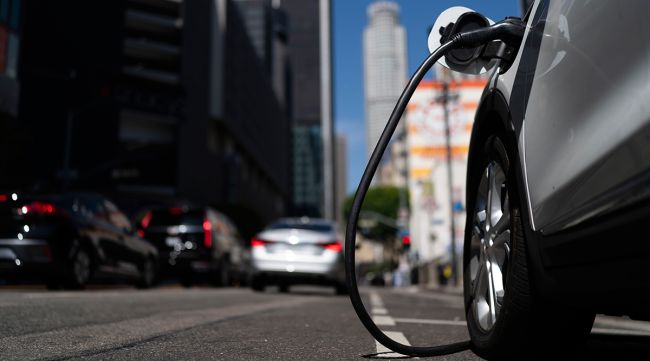The first of the chargers is expected to be ready in the summer of 2024. (Jae C. Hong/Associated Press)
DETROIT — Seven major automakers say they’re joining forces to build a North American electric vehicle charging network that would rival Tesla’s and nearly double the number of fast-charging plugs in the U.S. and Canada.
General Motors, BMW, Honda, Hyundai, Kia, Mercedes and Stellantis said July 26 that they will share in a multibillion-dollar investment to build “high power” charging stations with 30,000 plugs in urban areas and along travel corridors by 2030.
The dramatic move is intended to speed the adoption of electric vehicles, allaying fears that chargers won’t be available for long-distance travel.
The companies wouldn’t disclose the exact number of charging stations or financial details of the joint venture they’re forming to put the network in place. While they said the first of the chargers will be ready by next summer, they also would not say how long it will take to build the entire network.
The automakers said in a joint statement July 26 that they want to build the “leading network” of reliable high-powered charging stations in North America.

Tesla’s network has 2,050 stations and more than 22,000 plugs in the U.S. and Canada. (George Walker IV/Associated Press)
“The parties have agreed not to disclose specific investment numbers at this time, but the seven founding automakers intend to work as equals to ensure the success of the joint venture,” the companies said in a written statement answering questions from the Associated Press. “As you can imagine, such a high-powered charging network of this scale requires a multibillion-dollar investment.”
There are currently just under 8,700 direct-current fast-charging stations in the U.S. and Canada with nearly 36,000 charging plugs, according to the U.S. Department of Energy.
Fast chargers can get a battery to 80% of its capacity in 20 minutes to one hour, making them optimal for travel corridors and in some cases comparable to a gasoline fill-up. They’re much quicker than 240-volt “Level 2” chargers that can take hours to get a battery to a full charge.

How effective have third-party services proved to be for fleets? Let’s find out with Michael Precia of Fleetworthy Solutions and Dan Rutherford with Summit Virtual CFO by Anders. Tune in above or by going to RoadSigns.ttnews.com.
The new network is expected to have 10 to 20 charging plugs per station, meaning there would be a minimum of 1,500 stations and a maximum of about 3,000.
Tesla’s network, with the largest number of fast chargers in North America, has 2,050 stations and more than 22,000 plugs in the U.S. and Canada, the DOE says.
The network formed by the seven automakers would be public and open to all electric vehicle owners. It will have connectors for both Tesla’s North American Charging Standard plugs as well as the Combined Charging System plugs used by other automakers.
The automakers will seek to use U.S. government funds from the bipartisan infrastructure law to help pay for the network.
“This joint venture will be a critical step in accelerating EV adoption across the U.S. and Canada,” Honda CEO Toshihiro Mibe said in a statement.






